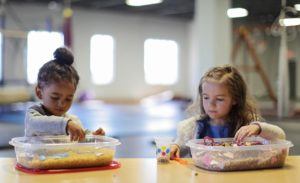Sensory
We know we need to limit our kids’ screen time but how often do we parents think about our own screen time and how it impacts our children? There are countless articles on the dangers of screens for our children but now more concern than ever is being raised about parents’ screen time.
I stay home with my sons two days a week and countless times I’ve been at the park/swim lessons/restaurants with them and nearly every parent is on their phone. They aren’t interacting with each other and certainly aren’t interacting with their children. Not only our we losing an opportunity to build our village but we are losing out on precious moments with our children that we can’t get back.

This article from psych central discusses five reasons to put our phones away and be present for our children.
https://psychcentral.com/lib/put-your-phone-away-and-pay-attention-to-your-kids/
The last point stating that “Our kids need our first priority to be our relationships with them, not with our phones” should truly be all we need to read. There is so much for us to teach our children and they crave our attention, our encouragement, and our love. When our heads are buried in our phones we aren’t living real life and providing our children with all they need to properly develop and deserve.
I’ve deleted social media apps from my own phone in an effort to disengage from it. My wife struggles more so and recently experienced a little gut punch when our 5-year-old said he didn’t want her on her phone so much.
So what can you do?
- Have a designated place to put your phones when you get home and basically don’t touch them until the kids are in bed. This especially means NO PHONES AT THE DINNER TABLE. This is our current strategy and the one we are finding the most success with. It gives us uninterrupted, quality time with the kids and spouse and it also feels good to disconnect nightly
- Turnoff notifications for your apps. DO THIS. Don’t be a slave to every little ping your phone makes. Very little of it is so important that it can’t wait a couple hours
- Use apps the monitor usage and post reminders to put your phone down. A list can be found here but my wife warns they are effective at first but can be easy to ignore over time https://www.digitaltrends.com/mobile/best-apps-for-limiting-your-screen-time/
- Remember your manners! When your engaged in conversation or an activity with your child, don’t let a chirp from your phone interrupt the moment. That new Instagram post will be there later
Speaking of screen time, have you seen it impact your child?
The near nightly question we dread: “Can we have a video game night?”
Our 5-year-old loves playing video games, even on our old original and super Nintendos. He also loves to watch people play video games, Mario Brothers specifically, on YouTube. But we noticed behavior changes while he played and after playing video games or viewing someone else playing them.
Things came to a head when we let him watch A LOT of Mario Brothers on YouTube one Saturday morning as we slept in along with the baby. When we went to his t-ball game later at lunchtime he struggled through some tears when he didn’t have the chance to field the ball and then as he whiffed at bat and a few kids laughed. At the very end of the game he and another boy tussled over fielding the ball and our son kicked his teammate. We were gob smacked, apologetic, and deeply embarrassed. We were also confused because this just wasn’t our son.
This well-publicized article in the New York Post from 2016 may feel a little over-dramatic in it’s opening but its warning was not lost on us.
https://nypost.com/2016/08/27/its-digital-heroin-how-screens-turn-kids-into-psychotic-junkies/
My wife, a former software engineer and current Information Technology analyst, shares my low-tech approach to parenting for many of the exact concerns raised in the article. Because our children are young we didn’t know where the line was exactly but we certainly figured it out the hard way.
The YouTube app is no longer on our TV and video game night occurs about once a month. The tablet has never been a “thing” at our house but he does get to play on one infrequently at the sitters so he’s not completely void of technology because, after all, it is the future. He still asks almost daily to have a video game night and as much as we want to say yes, we continue to say no most of the time.

Setting the technology boundaries with young ones is pretty easy as long as you can stick to it through the tantrums. But what about older kids that have already been given a long leash when it comes to technology (or no leash at all)? A conversation about their usage is likely in order and perhaps it needs to be a family discussion if you found you struggle with your usage as well. Consider a gradual transitions and/or replacement activities to help wean them off. You can find some valuable tips on limiting screen time here: https://www.verywellfamily.com/tips-for-limiting-electronics-and-screen-time-for-kids-1094870

And remember, kids learn behaviors from their parents. If you are spending too much time on your device then they likely will too.
ABC Pediatric Therapy Network, http://www.abcpediatrictherapy.com, cares about families. Some children can have attention and/or sensory issues from too much screen time. Let us help if you have concerns about your child.
For more information visit http://www.abcpediatrictherapy.com
Read More

Winter time can be difficult for kids and parents, especially kids with higher sensory needs. Being stuck inside more means less time outside and fewer options for movement activities. Here are some ideas to get your kids moving and to keep them busy during those long winter months:
– Check out your local library for different classes they have – they often have story time and other free programs
– Many fast food restaurants or indoor malls can have play areas where they can climb and slide
– Stores that sell playground equipment will often have the option to play on equipment indoors for a small cost
– Children’s museums or other museums – some of them have a cost and others are free to the public
– Cooking or craft classes
– Indoor play cafes
– Nature centers
-Play in the snow!

– At home:
o Make an indoor obstacle course
o Science experiments
o Make homemade playdough
o Indoor snowball fight using wool dryer balls or rolled up socks
o Rice and bean bins
o Shaving cream, kinetic sand, play dough, putty activities
o Indoor scavenger hunt
o Create structures using marshmallows and toothpicks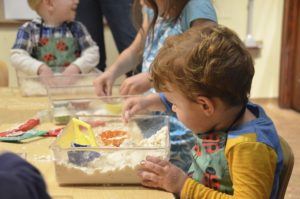
o Build a cardboard house
Continue to challenge your child’s development everyday. If you have any concerns, visit our website https://www.abcpediatrictherapy.com or give us a call. We are happy to help!
Read MoreKids LOVE Halloween…between dressing up, the decorations, parties, and of course the candy…what’s not to love? But let’s be honest, Halloween is definitely not the most sensory friendly holiday. For kids with sensory processing disorder, it can be a literal nightmare. From the itchy costumes, flashing lights, loud noises, and unexpected scares, the night of Trick-or-Treat can be really overwhelming for you and your child. Below are 6 ways to have a sensory friendly Halloween this year!
- The costume…perhaps the most important step that you can control! Some costumes are scratchy, come with face paint that can be sticky or slimy, masks that smell funny, or other head pieces, that can just be painful for kids with sensory issues. Take your child with you to the store to feel the costume and gage their reaction when they touch the costume. That will give you a good idea if they’d be able to tolerate it for a whole evening or not. You could also have them wear some of their most comfortable clothes under their costumes. Or focus on using some of their own clothing to make a unique costume, keep it simple like a cowboy or a cat! When in doubt, do a trial run a few days before to ensure their comfort…you’ll appreciate it later when you have avoided a meltdown.

- Practice, practice, practice! Set-up time for you and your family to practice Halloween etiquette. First start with your own home, where things are most familiar. Work on ringing the door bell, what to say/how to respond, and how to take the candy…that way they know what to expect and can learn the routine. Next practice at a family or friends house, where things are familiar. It’s much easier to practice on a familiar face than a stranger.
- Plan your Trick-or- Treat route ahead of time. Try to Trick-or-Treat at neighbors who know you and your kids if possible. It is always easier to go to familiar places with familiar people. And you will also feel comfortable asking them questions like: what kind of decorations they have in their yard. Or they will not get offended if your kiddo is getting overstimulated and does not say “thank you” or respond appropriately to a question.
- P
 lan your time accordingly. Going Trick-or-Treating earlier in the night can be helpful, as it is often less crowded initially. Your child may benefit from a picture schedule, timer, or checklist so they know what to expect! Incorporating “break” times in which they can go back to the house or into your car, can help sensory overload. Be aware of your child’s warning signs that they might be getting overstimulated.
lan your time accordingly. Going Trick-or-Treating earlier in the night can be helpful, as it is often less crowded initially. Your child may benefit from a picture schedule, timer, or checklist so they know what to expect! Incorporating “break” times in which they can go back to the house or into your car, can help sensory overload. Be aware of your child’s warning signs that they might be getting overstimulated. - Go to smaller events…Trunk-or-Treats, mall, and/or church events are becoming increasingly popular, especially for parents who work, thus limiting the time families can go Trick-or-Treating. These events tend to be for kids of all ages, so it could limit the number of scary masks or decorations you encounter. This will greatly reduce the amount of transitions for you to navigate as well! These events can get crowded, so be sure to call ahead, to see what times tend to be less busy or how many people they are expecting.
 Make your own Halloween Traditions. When all is said and done, there is no rule saying you have to participate in any of these activities. If they are too much, it’s simply too much! Take it in stride and create your own Halloween traditions, by making it a pizza or game night, do
Make your own Halloween Traditions. When all is said and done, there is no rule saying you have to participate in any of these activities. If they are too much, it’s simply too much! Take it in stride and create your own Halloween traditions, by making it a pizza or game night, do  your child’s favorite activity, or have a special Mommy or Daddy only date every year to make the holiday special in another way.
your child’s favorite activity, or have a special Mommy or Daddy only date every year to make the holiday special in another way.
I hope these recommendations help you and your child have a happy and safe Halloween! Be sure to visit our website for other fun tips and information www.abcpediatrictherapy.com
Read MoreDid you know by 3 your child’s diet should typically consist of a variety foods with various textures, sights, temperatures, colors and consistencies? If your child is not eating a variety of fruits, vegetables, meats, and mixed foods (such as mac and cheese or spaghetti), then your child may be a picky eater.
Before addressing feeding, make sure you child’s sensory needs are being meet. Sometimes addressing sensory concerns, such as deficits in proprioceptive input (knowing where your body is in space through heavy work or deep pressure), vestibular input (movements such as swinging), and or tactile input (how your body reacts to touch) can be enough input to help your child try new foods.
Having your child jump on the trampoline or in place, wheelbarrow walk or any animal walk to the dinner table, and or swing prior to eating could be good activities to complete before meal time. Your child could also benefit from the brushing protocol to help with sensory input (contact an occupational therapist at ABC Pediatric Therapy for more information on this protocol). Also, make sure child is okay with getting messy. If s/he is not, it will be beneficial to address this first as well.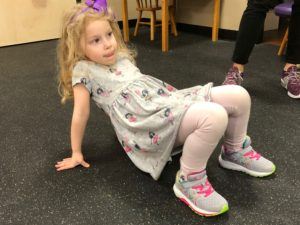
Using shaving cream is one of the easiest messy play activities. At first, make sure your child tolerates being in the same area as the shaving room. Once s/he tolerates being near the shaving cream, have your child begin interacting with it. Put cars, planes, or boats in it and have the child push these around without touching the shaving cream. Slowly begin introducing shaving cream onto the cars and see if your child will continue to touch the cars. Once they do, see if your child will imitate you drawing roads for these cars in the shaving cream. After your child tolerates interacting appropriately with the shaving cream your child is ready to begin trying new foods.
Dr. Kay Toomey developed a feeding hierarchy that has been proven to have great success is regards to sensory picky eaters. Following along the same lines as shaving cream play, Dr. Toomey wants children to be able to tolerate and interact with new foods before actually eating them. If they are not able to tolerate being at the table with the food, then they are not going to be able to interact with it.
To assist with interacting with food, have your child prepare food and use utensils or the container to stir or pour foods/drinks. If your child is having difficulty with using utensils and self-feeding skills, please contact an occupational therapist for additional assistance.
Once your child interacts with foods, the next step on the hierarchy is to smell the foods; have your child lean down or pick it up to smell the food. The next big step is touching foods; go from touching it to his/her fingers to whole hand to chin/nose to lips to teeth to tip of tongue to full tongue to licking it. At this point, reward your child with a preferred food after 1-3 consecutive touches or licks of a non-preferred food. After your child is licking new foods, the next step is to begin tasting them. Initially have him/her take a small bite and designate a spit out jar. Once s/he is able to do this, see if your child can hold the food in his/her mouth for a certain amount of time or even chewing a certain amount of times before spitting out. The next goal would be to chew and swallow with a drink and then independently. Also, at this point, begin rewarding your child with a preferred food after so many bites of a non-preferred food. For example, have your child take 2 small bites of a green bean before being rewarded a preferred gold fish and then repeat this until you are satisfied with how many bites of a non preferred food your child is eating in one sitting.
If your child is not making the progress you want, your child may have oral motor deficits. For example, if your child is only eating softer, blander foods, they may have decreased strength. They may also have an immature chew which could make feeding difficult. An occupational therapist would also be able to assess this. A therapist will also be able to determine if your child is having sensitivities to the temperature, texture, flavor, sight, or smell of certain foods which could be inhibiting his/her success.
Please contact ABC Pediatric Therapy for more ideas geared towards your specific needs and if you have any additional questions. Visit our website at www.abcpediatrictherapy.com to find the location nearest you.
Read More1. Understand the time your child should be able to attend to a seated task.
1 year: 1 minute
2 years: 2-4 minutes
3 years: 8 minutes
4 years: 10 minutes
5 years and up: 15 minutes
2. Give your child plenty of sensory/movement breaks throughout the day.
In today’s world, children are not given the breaks they need to function to their fullest potential. Allowing children to move around throughout the day will give them opportunities to let their energy out and ideally focus better when they are sitting. Running, climbing, jumping, and participating at recess is one of the best sensory motor activities a child can do at school. However, if the child needs more breaks or more structured activities during the day provide the following:
3. Provide proprioceptive input/heavy work through the school day.
Proprioceptive input activities involve heavy resistance and input to the muscles and joints. Engaging in these activities may help regulate a child’s arousal level, concentration, and ability to sit still/attend to a task.
· Wall/chair push ups
· Animal walks like crab walks
· Jumping up and down
· Sit ups
· Push ups
· Jumping jacks
· Wheelbarrow walks
· Arm Squeezes/self-hugs
· Complete activities in prone/on belly
· Chew on tougher consistencies, chew tubes, or hard candy
· Drink water through a straw
· Play oral motor games with straws during breaks
· Eat crunchy foods at meal times
· Apply a weighted blanket 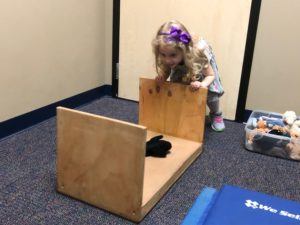
· Wear tighter clothing
· Pushing/pulling heavy objects
· Give the child more chores to complete around the classroom—wiping off dry erase/chalk board, putting up/pushing in chairs, washing tables, rearranging book shelves, sharpening pencils, carrying heavy boxes, cutting thick paper, etc.
4. Do these activities at home to continue regulating your child’s body. This can even help with homework time if your child is having a hard time concentrating at home.
5. Make breaks cards so your child is not abusing getting out of work both at work and at school.
Make a card for teacher’s choice, child’s choice, and proprioceptive input/heavy work. Have at least 2 of each type of card.
6. Talk to the teacher to determine if there are environmental changes that can be made.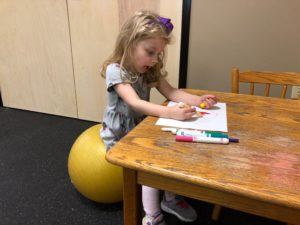
Could your child benefit from fidgets, wiggle seats, or TheraBand applied to their desk? Does your child have to sit on the floor during circle time? See if your teacher could use a designated carpet square to make a specific area for your child to sit.
7. Reflex Integration Testing
It may be beneficial to contact ABC Pediatric Therapy to have your child’s reflexes tested. Some of your child’s reflexes may not have integrated correctly when s/he were a baby which could cause difficulty with attention/focus, sitting upright in a chair, and some other deficits that are inhibiting your child’s full potential to learn.
8. Contact ABC Pediatric Therapy specifically an occupational therapist for more ideas geared towards your specific needs and if you have any additional questions. Visit our website at www.abcpediatrictherapy.com to find the location nearest you.
Read More Skip to content
Skip to content
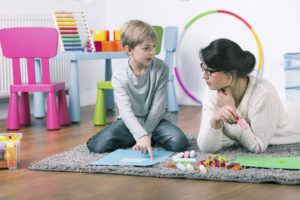

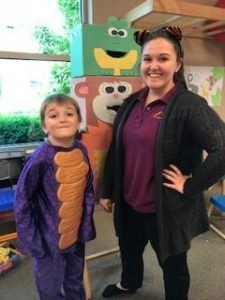
 lan your time accordingly. Going Trick-or-Treating earlier in the night can be helpful, as it is often less crowded initially. Your child may benefit from a picture schedule, timer, or checklist so they know what to expect! Incorporating “break” times in which they can go back to the house or into your car, can help sensory overload. Be aware of your child’s warning signs that they might be getting overstimulated.
lan your time accordingly. Going Trick-or-Treating earlier in the night can be helpful, as it is often less crowded initially. Your child may benefit from a picture schedule, timer, or checklist so they know what to expect! Incorporating “break” times in which they can go back to the house or into your car, can help sensory overload. Be aware of your child’s warning signs that they might be getting overstimulated. Make your own Halloween Traditions. When all is said and done, there is no rule saying you have to participate in any of these activities. If they are too much, it’s simply too much! Take it in stride and create your own Halloween traditions, by making it a pizza or game night, do
Make your own Halloween Traditions. When all is said and done, there is no rule saying you have to participate in any of these activities. If they are too much, it’s simply too much! Take it in stride and create your own Halloween traditions, by making it a pizza or game night, do 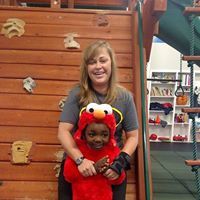 your child’s favorite activity, or have a special Mommy or Daddy only date every year to make the holiday special in another way.
your child’s favorite activity, or have a special Mommy or Daddy only date every year to make the holiday special in another way.
